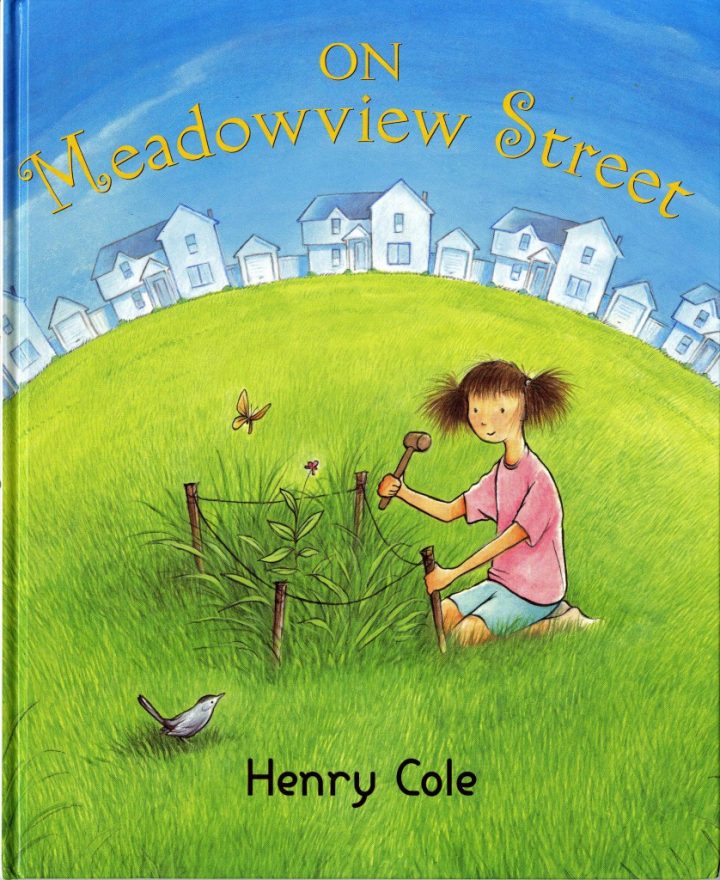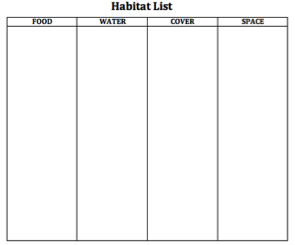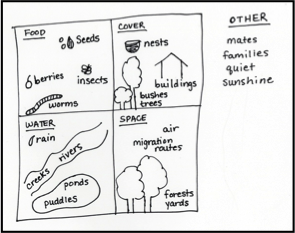On Meadowview Street
On Meadowview Street written and illustrated by Henry Cole

Topic: Making habitat improvements
Description:
Caroline has just moved into a new neighborhood where every yard looks exactly the same. There is nothing but lawns of mown grass. As her father begins to mow their lawn, Caroline spies a single, beautiful flower. She decides to protect it by creating a “wildflower preserve.” As she notices more flowers, her preserve begins to grow, and grow. Flowers are joined by butterflies, and soon her father sells their mower. When birds visit the yard, she and her father find ways to improve the habitat to make it a place for birds and other interesting creatures to call home. The gentle text and charming illustrations make this a lovely read aloud with an important message of how one girl’s actions created a thriving meadow ecosystem on Meadowview Street. Interested in Blending Science and the Language Arts? Watch our webinar on this at the bottom of the page!
Find On Meadowview Street on Amazon.
Explore habitat with our Feathered Friends resource. In the second lesson, called, What’s in a Habitat?, students explore the habitat needs of all animals (food, water, cover/shelter, space) and think about ways to make their yard or schoolyard a better place for birds.
Ask students to imagine they are a bird—any wild bird. Tell them to close their eyes and imagine where they are and how they live. Focus on habitat needs by slowly asking these questions as students visualize:
- Where do you live? What are you doing? What do you see?
- What do you eat? How do you eat? Where do you find food? (Food)
- Where do you get water? (Water)
- Where do you sleep? Where would you hide if something were trying to catch and eat you? Where do you find cover or shelter? (Cover)
- Where do you lay your eggs? Are your babies hidden? How? By what? (Cover)
- Is there enough of the right habitat for you to survive? How do you know? (Space. If a place does not provide the right food, water, and cover in the right arrangement/amounts, a plant or animal cannot live there.)
Pair students and ask them to interview their partner about what they imagined. After enough time to exchange ideas with partners, share ideas as a class, drawing attention to how each of the imagined birds used their habitat to survive. Have them specifically describe how or where their needs for food, water, cover, and space were met. You may wish to list student’s responses on the board or chart paper under the appropriate headings — food, water, cover, and space.
Remind students that birds rely on their habitat to provide the food, water, cover, and space that they need to survive. Cover includes nesting areas, places to sleep or rest, and places to hide or escape. Space refers to having enough of the right habitat for a plant or animal to survive. If a place does not provide the right food, water, and cover in the right arrangement and amounts, a bird cannot live there.
Have students make a Habitat List. Ask them to create a table on a sheet of paper. The table should be made up of four columns, each with one of the following headings — food, water, cover, and space — at the top. (Or create one to give to students, Figure 1.) For younger students, have them draw their ideas as in Figure 2.
Now, go out into the schoolyard. Ask students:
- “What food is available for birds here?
- Where can they find water?
- Are there places for birds to hide?
- To build a nest?
- To sleep?
- How much space is “green” (having plants) versus “developed” (pavement and buildings) in the schoolyard?”


Have students write their ideas in the correct column on their Habitat List sheet (or draw their ideas in the correct quadrant) to create a list of the ways or places birds can find what they need to survive in the habitat of the schoolyard. When you return to the classroom, let students compare their lists in small groups or as a whole class.
Now, revise or redo the posted list of the general ways birds can meet their habitat needs (from the Imagine Life as a Bird activity) to reflect the specific ways birds can meet those needs in your school yard. (Students should mention all four factors – food, water, cover, and space – as well as give reasonable suggestions for improvement related to habitat. For example, hang bird feeders with nearby cover; plant native wildflowers, fruit-bearing trees, or shrubs; put up a birdbath; clean up trash; or install nest boxes.)
Once students have compiled their lists of how birds can meet their need for food, water, cover and space in your schoolyard, start a discussion of the ways your schoolyard could be improved to help birds survive there.
After completing the Improve Our Habitat for Birds activity, lead your class in a discussion to decide on one project that they would like to undertake (for example, plant native plants, put in a bird bath or feeder). Discuss the project and any obstacles that may need addressed, like funding, manpower, materials, timing.
Devise a plan to implement your project making sure not to forget to discuss anything that needs to be “solved.” You might encourage students to work in small groups to brainstorm answers to the Project Planning Questions below. Have students create a project map or drawing. Then, as a class, develop the final action plan for making some of these changes to your schoolyard.
Project Planning Questions:
- What will the project cost?
- What are our goals? How will we accomplish them?
- What might be our obstacles and how can we address them?
- Who needs to be involved? What are their roles?
- What materials do we need?
- Where and when will the project take place?
Implement the habitat improvement(s) plan the class agreed upon and devised. It’s okay if your actions are small to start!
Free Webinar: Blending Science and Language Arts
Additional Resources:
On the National Wildlife Federation’s Garden for Wildlife site, you will learn why it is important for a habitat to provide food, water, cover, and a place for wildlife to raise their young. You will learn how to assess what is already in place and/or what needs to be added, not only to help wildlife, but to qualify your schoolyard (and your own yard) as an official Certified Wildlife Habitat®. There is a lot of useful information on this site; many instructive articles and helpful resources are provided.
Celebrate Urban Birds is one of the Lab’s participatory-science projects. It promotes appreciation for the birds found in urban areas and encourages its participants to make urban spaces more habitable for their feathered friends.
All About Birds is an extensive, easy-to-use guide for identifying birds found in North America. The guide also includes information on the habitat needs of each species, so that you can make your space more habitable for the birds in your area.
Google Earth gives you a bird’s eye view of your neighborhood ecosystem.
The National Invasive Species Information Center provides information on common invasive species found in the United States. Adding native plants and removing invasive species is one way to improve your backyard habitat. Find the list of common invasive species for your state.
Bird Friendly Homes on the All About Birds website offers tips, tricks and other useful information on attracting birds to your yard as well as how to deal with problem species such as European Starlings and Canada Geese.